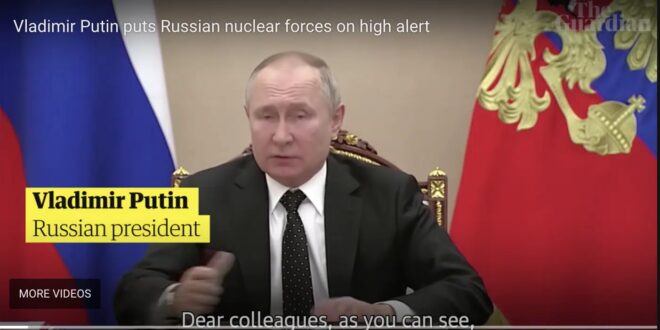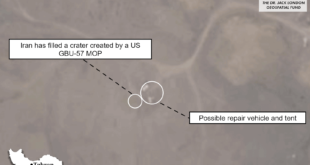Nuclear experts are trained to think the unthinkable. So, here is an unthinkable scenario that might actually happen in real life:
The battle over Ukraine drags on. From both the European Union and the United States, fresh weapons and other supplies continue to enter into Ukraine and allow the Ukrainian forces to fight on. The battle reaches what conflict resolution expert William Zartman calls “a hurting stalemate” situation. The balance of forces on the ground is not completely or perfectly symmetrical, but what was once considered a completely disproportioned asymmetry of forces has been gradually re-equilibrated, in favor of the Ukrainian forces.
The crisis becomes a war of endurance.
Theories of international relations tell us the defenders have a strategic advantage. They know the terrain in which they fight, and above all they have an absolute resolve to repulse the attacker. What news outlets report largely confirms these theoretical arguments. The extraordinary competence of the Ukrainian military is further strengthened by an unprecedented level of civilian mobilization and resistance.
Meanwhile, Russian forces meet considerable challenges in re-supplying their forward-deployed troops. The army has visibly underperformed. No strategic objective has been achieved. And for the first time since the beginning of the conflict, the Russian media acknowledge the country’s first causalities. As the situation endures, Russian troop morale wanes. Fighting becomes sloppy, casualties continue to climb on the Russian side.
Generally, in a situation of hurting stalemate, according to Zartman, the costs of continuing the struggle exceed (oftentimes greatly exceed) the benefits to be gained. Yet, it is reasonable to assume that for Putin, losing the war with Ukraine is a non-option. He has claimed Ukraine is an indivisible part of the Russian identity and territory. In addition, with two-thirds of Russia’s entire military forces on the ground, losing a war against what is perceived as a much weaker military would inflict major reputational costs to the Russian Federation and to Putin.
Neither might he be willing to accept a negotiated solution that leaves the current regime in power. The costs that Putin has been already willing to pay for his invasion of Ukraine have been astronomical. Settling for a half-baked victory seems very unlikely. For the costs of the invasion to be worth it, Putin needs a decisive victory.
The question of what “winning” means for Putin comes into play.
What options does Putin have? A decision by Putin to use tactical nuclear weapons seems, perhaps, no longer completely far-fetched. In fact, he ordered Russia’s nuclear forces to a higher alert status on Sunday, although it was unclear what the order meant in practical terms. The land- and submarine-based nuclear missiles of Russia and the United States are generally thought to be kept at high readiness at all times.
Today, as I write this article, a scenario that leads Russia to use nuclear weapons in Ukraine seems improbable. Like many others, I make three assumptions: that Russia has a strong interest in not destroying Ukraine, because Putin wants to occupy it; that even though Putin is a thug, he is not a crazy enough thug to break a taboo against the use of nuclear weapons in war, a taboo that has held for 75 years; and that there are plenty of other options that the Russians can exercise in subduing Ukraine.
But perhaps those assumptions should be questioned.
First, the assumption that Putin wants to avoid destroying Ukraine hardly stands the test of reality. While it was true that in the first phase of the conflict the Russians took measures to reduce civilian costs and infrastructure destruction, in the last 24 hours, Russian tactics have shown a clear change in targeting and pace. The targeting of residential buildings, gas pipelines, and energy stations is indicative of how much the Russians now feel the urgency of time and the fear that Ukrainian resistance is coalescing. The longer the conflict drags on, the more the Russians will have to escalate to break the “resolve” of the Ukrainians. Ultimately, having a decisive victory might matter more to Putin than the preservation of infrastructure. And if Putin’s goal is to make Ukraine a buffer zone between Russia and the West, limiting damage on Ukraine soil might ultimately count little in Putin’s mind.
As regards the second assumption: How much crazier would Putin need to be, to break the so-called “nuclear taboo”? It seems to me that he has been willing to break the taboo regarding national sovereignty more than once. While I don’t think he will take the decision of using tactical nuclear weapons lightly, I also don’t believe that the fear of breaking a precedent (real or imaginary) is something that would constrain him. It is interesting also to note that Putin has repeatedly referred to nuclear weapons during this crisis. On Sunday, he ordered his country’s nuclear forces on high alert in what he said was a response to aggressive statements from Western countries. In the speech that announced the invasion of Ukraine, Putin claimed that “Ukraine was on the path to acquiring nuclear weapons.” No proof exists of course to support such a claim, but it is interesting to note how preeminent the nuclear argument plays in Putin’s thinking. More important, the Russians apparently are considering a retaliatory measure to push back against the West’s support of Ukraine; it would include Russia leaving the New START nuclear arms control agreement, which caps the deployed nuclear arsenals of the United States and Russia—a move implied on Saturday by former Russian President Dmitry Medvedev, currently deputy head of Russia’s Security Council.
Finally, we know the Russians still have plenty of conventional and non-nuclear strategic options. They have not deployed their full cyber capabilities. More tanks are being sent in. Use of swarm drones and other “exotic” weapons might also be in the planning phase. And several of my colleagues at the Belfer Center have pointed out, Russia has enough fire power to destroy Ukrainian cities without having to resort to nuclear weapons.
In addition, as this mad war rages on, windows for diplomacy and negotiations might appear along the way. One seems to be opening tomorrow, with talks between Russian and Ukrainian delegations set to begin in Belarus.
What makes the use of tactical nuclear weapons plausible (although not likely) to me is their unequivocal messaging value. The use of one or more tactical nuclear weapons would be an unmissable attempt by Putin to break the unity of the West, and to test the resolve of some NATO countries. It would also signal once and for all his willingness to do whatever it takes to achieve his political and strategic goals.
I don’t claim this is a likely scenario, but I do worry.
I have celebrated the military victories of the fierce and proud Ukrainians. I cried over the images showing on TV. I gasped in reading the messages of President Zelensky confirming over and over his unshakable will to stay and fight with the Ukrainian people until the end. But a more ominous scenario is emerging and with it a catastrophic dilemma for both President Zelensky and the West. The longer he and the West resist, the more they might involuntarily push Putin to consider further escalations, including to the nuclear threshold. Should Zelensky surrender and leave, hoping to appease Russia? Or should he continue to fight with his people, with increasing help from the West, to defend their right to live freely? Is the fight for freedom worth the price of a possible nuclear attack?
This is an existential dilemma without a perfect solution, one that nobody should ever face. It’s a dilemma that could haunt us all soon, unless sanity is restored by renewed diplomacy.
 Eurasia Press & News
Eurasia Press & News




